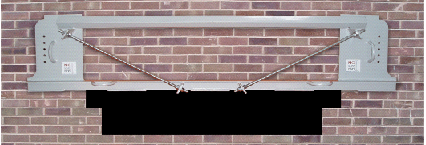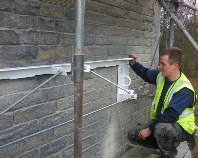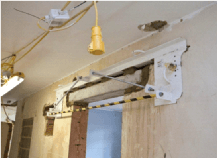About No More Props
 No More Props is a temporary lintel. It is a quicker, easier and safer alternative to using acrows and needles or strongboys.
No More Props is a temporary lintel. It is a quicker, easier and safer alternative to using acrows and needles or strongboys.
It’s a single tool that replaces the need for multiple acrows, saving site preparation time and cutting job time in half, particularly on upper floor work.
No More Props can be used on flat faced stone, block work and brickwork. Depending on the job, it can be used on its own, or in combination with No More Props Tight Space. Both the temporary lintels allow the quick and easy replacement, or installation of permanent concrete, steel or Catnic lintels in single skin, double skin or cavity walls.
It’s ideal for installing new lintels, or replacing lintels that are cracked and unsafe. If you’re knocking through a wall to form a new door, window or opening into a new extension or conservatory, then you can do the job more safely and in about half the time that it would take using acrows and strongboys. And, if you’re doing a job on an upper floor, then No More Props is an incredible time saver, as unlike acrows, you don’t need to point load, prop to ground or apply for a Temporary Works Certificate to ensure the ground’s suitability for propping.
 Sometimes there is a need to insert a permanent lintel close to a ceiling or soffit and there’s not enough clearance to install No More Props. In this case, No More Props Tight Space is used.
Sometimes there is a need to insert a permanent lintel close to a ceiling or soffit and there’s not enough clearance to install No More Props. In this case, No More Props Tight Space is used.
No More Props exceeds by a large factor the typical load a lintel has to bear, meaning it is well engineered for its task, and provides a high degree of safety. It exceeds by 13 times the BS Standard’s requirement for the load bearing of a permanent lintel. (See the ‘Load Bearing Capability’ page for full load bearing details of all sizes).

 No More Props can be used on flat faced stone, block work and brickwork. Depending on the job, it can be used on its own, or in combination with No More Props Tight Space. Both the temporary lintels allow the quick and easy replacement, or installation of permanent concrete, steel or Catnic lintels in single skin, double skin or cavity walls.
No More Props can be used on flat faced stone, block work and brickwork. Depending on the job, it can be used on its own, or in combination with No More Props Tight Space. Both the temporary lintels allow the quick and easy replacement, or installation of permanent concrete, steel or Catnic lintels in single skin, double skin or cavity walls.
